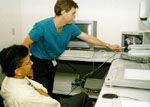System extends MUSC reach across state
by Dick PetersonPublic Relations
 MUSC
pediatric cardiologist Dr. Girish Shirali, seated, and Dr. Andrew Atz,
director of the MUSC pediatric intensive care unit, read an echocardiogram
of a three-pound premature infant transmitted to him from Self Memorial
Hospital in Greenwood. As the infant’s tiny heart pulsed, Shirali directed
the technologist at Self to position the images in angles that allowed
him to see the formation of heart chambers and valves, monitor blood flow
by adding color, and take measurements of valve and chamber openings. He
was able to diagnose the infant’s heart condition as accurately as if she
had been in the room with him instead of about 200 miles away.
MUSC
pediatric cardiologist Dr. Girish Shirali, seated, and Dr. Andrew Atz,
director of the MUSC pediatric intensive care unit, read an echocardiogram
of a three-pound premature infant transmitted to him from Self Memorial
Hospital in Greenwood. As the infant’s tiny heart pulsed, Shirali directed
the technologist at Self to position the images in angles that allowed
him to see the formation of heart chambers and valves, monitor blood flow
by adding color, and take measurements of valve and chamber openings. He
was able to diagnose the infant’s heart condition as accurately as if she
had been in the room with him instead of about 200 miles away.
Until recently, parents of an infant born with a suspected heart problem at Self Memorial Hospital in Greenwood probably wouldn’t consider seeking diagnosis and care from pediatric cardiologists at MUSC.
Why would they opt for a 200-mile, possibly unnecessary, helicopter flight to the Lowcountry with the Medical College of Georgia in Augusta only a 30-minute ambulance drive away? Even with top specialists ready for the infant’s arrival, the delay could be considered irresponsible.
But now that the MUSC Children’s Heart Program of South Carolina has installed a fully interactive telemedicine system at Self Memorial, all that’s changed. MUSC specialists in the Children’s Hospital can peer into the delicate chambers of a tiny heart through a large format video screen as they direct the positioning of an echocardiogram operated by a technologist at Self. Physicians at Self also have full visual and audio communication with physicians at MUSC.
“Our cardiologists here can determine if there really is a heart defect. And they can know if the condition is critical and warrants immediate transport,” said MUSC pediatric cardiology manager Joan Janes. A 30-minute transport to MUSC by MEDUCARE helicopter puts the infant in the care of some of the best pediatric heart specialists and facilities in the country, Janes said.
The telemedicine installation at Self is the program’s first, but more are planned for other South Carolina locations remote from MUSC. The Children’s Heart Program divides the state into four geographical regions: the Upstate, centered at Greenville Hospital Systems, Greenville; the Midlands, USC/Richland Memorial Hospital, Columbia; the Piedmont, McLeod Hospital, Florence and the Lowcountry, centered at MUSC, Charleston.
“While Self Memorial has long had the capacity to perform echocardiograms on infants, a pediatric cardiologist was not always available locally to interpret the results,” said Self Memorial spokesman Dan Branyon. He said that the hospital does have cardiologists to read echocardiograms involving adults and older children.
The telemedicine system employs three monitors: one at Self Memorial’s neonatal intensive care unit, and the other two here. ISDN lines transmit echocardiogram images originating at Self to one of the two units here for simultaneous interpretation by a pediatric cardiologist.
“This new technology marks a first in the state for the transmission
of neonatal echocardiograms from one facility to another for interpretation,”
said Self Memorial neonatology chief Terry Marshall, M.D. “It’s a step
forward for infants here identified as possibly having heart problems.”
MUSC pediatric cardiologist Girish Shirali, M.D., said the equipment
produces high quality images that can be easily read.
“If the tests reveal a serious heart problem, the child can be referred
to MUSC or another facility offering comprehensive heart services for infants,”
Shirali said. “If not, the parents are spared the time and trouble of driving
out of town.”
Branyon said that the new technology also will allow Self Memorial
to link up with other facilities, and can be used for training, other medical
programs and virtually any other purpose served by videoconferencing.